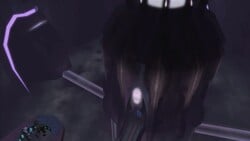- "Here rests the vanguard of the Great Journey. Every Arbiter, from first to last. Each one created and consumed in times of extraordinary crisis."
- — Prophet of Truth
The Mausoleum of the Arbiter was a massive room within the Covenant holy city of High Charity which housed the remains of the previous Arbiters.
Summary
A large suspended sarcophagus held the special Arbiter armor until it was needed again. It is unknown if it's the same armor each time, as all Elites would (in reality) be different sizes. This is very noticeable between past Arbiter Ripa 'Moramee and current Arbiter, Thel 'Vadam, making it likely a sham by the Prophets, who keep the armor less advanced for religious reasons. Another contributing factor to this theory is the destruction of Ripa 'Moramee's corpse at the Apex, meaning that the original armor of the Arbiter was not shared by all Arbiters. Additionally, should the prophets' order to kill Thel 'Vadam have succeeded his armor would not have been salvaged.
The Mausoleum of the Arbiter also contained the (recoverable) remains of every Elite that has ever been designated as the Arbiter. A total of 182 caskets are present spreading far up into the ceiling. Arbiters are only appointed in times of dire need, such as the Taming of the Hunters, the Grunt Rebellion, the Third Battle of Harvest and the Battle of the Gas Mine.
Appearances
The Mausoleum of the Arbiter initially appeared in the cutscene before the Halo 2 level, The Arbiter. Where Thel Vadamee was taken there by Tartarus and his two Brute ushers. Truth and Mercy ordered Tartarus to release the future Arbiter and leave. They started to converse with him about the Heretic Leader, the past Arbiters, and gave him the ornate armor of the Arbiter there.
It was next seen some time later, near the end of Gravemind. Here the Master Chief had to engage in a large-scale battle in order to go further into High Charity and find the platform with the Phantoms that were used to transport Truth, Mercy, Tartarus, Miranda Keyes and Sergeant Johnson to their respective locations.
The Mausoleum was the location in which Breaking Benjamin's Blow Me Away is played in-game during the fight between Covenant Loyalists and Covenant Separatists. It sounded like an instrumental version but was in-fact actually the real song: if you listen closely, you will notice that the vocals volume has been greatly lowered.
After that, it was seen for the last time in Halo 2 on the level High Charity. Upon reaching the huge tower and looking down, the player could see it surrounded by a layer of clouds and a storm. Above it, hangs the Step of Silence.
The Mausoleum was last seen visible in Halo 3 during the level Cortana. It is seen at different points through the "windows" formed by the Flood's consumption of the city. Energy cascades across the surface which leaned dangerously over to the side and cables hung from the shattered bridges around the tower. It can be assumed that the Mausoleum and the Vanguards of the Great Journey entombed within were destroyed when High Charity's reactor went critical, as spurred by Spartan-117 in the previous raid.
Trivia
- In the early version of the level Cortana, Master Chief would have passed through the Mausoleum, encountering an army of Flood-infected Arbiters. This idea was scrapped however, when both Flood levels were redesigned, possibly because the Arbiters would have been armorless. Another reason could be that over time, the Arbiter bodies could have decomposed like normal bodies after being in the caskets for so long. Though it is possible that some method of preservation is used in the caskets, but due to the fact that most Arbiters are only respected because of their title, it is unlikely.[1]
- It would seem that the Mausoleum was located close to the Detention Center, as seen in the cutscene level The Heretic, despite the path taken in Gravemind, which makes it seem farther away.
Links
Internal
Sources
- ^ http://www.bungie.net/News/content.aspx?type=news&cid=13849, in the power point

